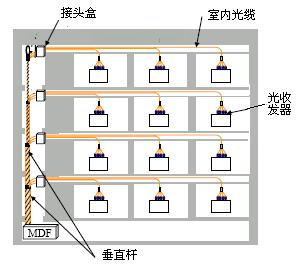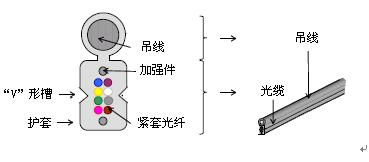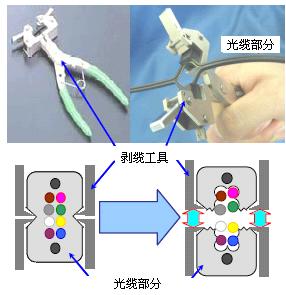Several kinds of FTTH indoor optical cables and their applications
This article mainly introduces several kinds of indoor optical cables currently applicable to FTTH technology, and focuses on the structural characteristics, application occasions, performance characteristics, and installation of the optical cable for a brief description.
Keywords: FTTH user optical cable, indoor optical cable, structural characteristics
1. Introduction With the rapid development of communication services, people have continuously improved the transmission performance and switching capabilities of communication networks. At present, the bandwidth of general copper wires can only reach 1M to 2M, while the bandwidth of optical fibers can reach as much as 100M. According to a survey by iSuppi, the global broadband market is expanding rapidly, and ADSL is beginning to transition to FTTX technology. It is expected that broadband equipment revenue and global users will maintain strong growth in the next few years. By 2011, global broadband equipment manufacturing revenue will increase from 11.2 billion US dollars in 2006 to 15.1 billion US dollars. At the same time, global broadband users will grow to 622.7 million in 2011, which is more than double the 270.4 million in 2006.
FTTH (fiber to the home) has been considered as the future development direction of the access network, and even FTTD (fiber to the desktop). In order to achieve this goal, people have made many efforts. Driven by the national "863" high-tech plan, China launched EPON technology research during the "Tenth Five-Year Plan" period. With the completion of the "863" EPON project, the country has established a fiber-to-the-home experiment network. At present, China Telecom has carried out FTTH pilots in Wuhan, Hangzhou, Shanghai, Guangzhou and other places, but the methods adopted are different, some are direct fiber to the home, some use FTTX + LAN, and some use FTTX + ADSL.
Therefore, the practicality of FTTH will promote the development of the optical fiber and cable industry, and the optical cable market has great potential.
Second, the optical cable in FTTH The optical cable used in FTTH is mainly divided into backbone optical cable, distribution optical cable and user optical cable according to the use location. The backbone fiber optic cable will have more cores, ranging from hundreds of cores to thousands of cores, usually using central tube, stranded and skeleton optical fiber ribbon cables. The current ordinary outdoor optical cables can meet the requirements and can be conveniently Use existing optical cable resources. The distribution optical cable is the optical cable between the optical distribution point and the user access point. According to different locations, the distribution optical cable can be selected from outdoor optical cable, indoor and outdoor dual-purpose optical cable and indoor optical cable. The user optical cable is the optical cable from the user access point to the terminal equipment. When the user access point is placed outdoors, the outdoor section should be introduced with outdoor optical cables or indoor and outdoor dual-purpose optical cables; when the user access point is placed indoors or inside the building, the user optical cable should use indoor optical cables.
The following will mainly introduce several indoor optical cables that can be used as lead-in optical cables and user optical cables and their applications.
3. The successive completion of indoor optical fiber networks and high-speed broadband access networks at various layers, and the increasing popularity of computer networks, continue to meet people's increasing demand for communication bandwidth. With the continuous extension of optical fiber to the user end, more and more indoor optical cables are used, and the market demand is heating up. From the inevitable development trend of vertical wiring systems and optical fibers to homes, as well as the needs of transmission equipment rooms and all-optical network switching, the demand for indoor optical cables is like telephone wiring cables, and it is no less than the demand for trunk optical cables, and is very suitable FTTH transmission medium. And the FTTH solution using indoor optical cable can simultaneously realize the triple play of the telephone, data, cable TV and video surveillance. The demand for indoor optical cables contains great growth potential, and it is expected that it will eventually account for about 50% of the nation's total optical fiber demand.
Due to the special installation occasions of indoor optical cables, the requirements for indoor optical cables are also more demanding. In addition to meeting the necessary optical transmission and mechanical properties, the performance of indoor optical cables must also meet the following characteristics: simple structure, small outer diameter, fire resistance, softness, easy bending, easy operation, etc. Environmental protection, mouse protection, lightning protection, waterproof, etc., and indoor optical cable in terms of UV radiation or waterproof performance is much lower than outdoor optical cable requirements. If waterproofing is indeed required, considering the ease of installation, a dry structure is generally used.
1. Introduction of optical cables At present, the wiring method of optical cables and other cables is the same, but there are some small changes in the route trend between different buildings. The following uses an example of the current common wiring method, as shown in Figure 1. 
Figure 1 The vertical distribution system main distribution frame (MDF) of the building is installed in the public area of ​​the building. The optical cable leads to each floor through a vertical rod, and then enters the room through the horizontal pipeline.
The optical cable used in Figure 1 is the introduction of optical cable. Users can choose user optical cables with different structures to achieve FTTH according to their needs and installation conditions. Now we introduce an 8-core suspension optical cable designed and developed by NTT. as shown in picture 2. 
Figure 2 8-core suspension type optical fiber cable. This cable uses PVC tight-fitting optical fiber, metal suspension wire, PVC or LSZH as a flame-retardant jacket layer, suitable for indoor wiring, stable and reliable performance; using small bending radius fiber production, has excellent Bending resistance; flame retardant; convenient and reliable construction. Special tools can be used for stripping the cable and stripping from the "V" groove area of ​​the optical cable to obtain a tight-fitting optical fiber, and the operation is simple. As shown in Figure 3. 
Figure 3 Stripping of 8-core suspension-type optical fiber cable
2. User optical cables User optical cables include single-core, double-core, beam tube multi-core, ribbon, "V" shaped optical cables, metal armored flexible optical cables, etc. There are many specifications of the outer diameter of the optical cable, which can adapt to the requirements of different connector sizes and wiring space environment, suitable for indoor wiring.
ï¬ The structure of a typical tight single / dual-core optical cable single / dual-core indoor optical cable is relatively single. The most typical structure is shown in Figure 4. The external dimensions are small, generally from 3mm to 3.4mm, and the amount of materials other than the optical fiber is reduced, which also improves the flexible bending performance of the optical fiber, which is very beneficial for indoor wiring. Only one connector is needed, which is convenient to connect with the terminal equipment, easily accepted by users, and has certain development prospects. In addition, if two loose tubes are twisted or twisted around the center piece of the medium, and then covered with aramid tow and outer sheath, it can be made into a 4-core indoor optical cable, but the size is still not large. The diameter is 3.3mm ~ 3.7mm, which can be used for LAN wiring. 
Figure 4 Typical single-core / dual-core optical cable
ï¬ Armored indoor soft optical cable:
With the advancement of FTTH, a user-friendly terminal (home, corridor) will need a cable that is as easy to use as a wire. Fiberhome has designed an indoor and outdoor integrated optical cable-armored indoor single-core optical cable has applied for a patent, the specific structure shown in Figure 5. The product is equipped with a metal hose in the optical cable, which significantly improves the compression resistance, tensile resistance and folding resistance of the optical cable, and at the same time prevents rat bite damage; high-strength aramid reinforcement ensures that the optical fiber has no tensile strain and the outer diameter is the standard optical cable The outer diameter is suitable for the application of various connector parts; the bending flexibility is good, the minimum radius of curvature can be up to 10 times the cable diameter; it is flame retardant; the size is small and the construction is convenient. 
Figure 5 Armored indoor soft optical cable This kind of optical cable is widely used in national defense communications, broadcast and television systems, building intelligent control, power control systems, transportation communication systems, metropolitan area networks and local area networks. Specific applications are:
It is suitable for indoor and outdoor direct laying optical cables along the wall, roof, mezzanine and conduit connection. The pigtails and movable connecting cables of communication equipment designed and produced with a standard and strong structure can be directly used for connection between the equipment.
Indoor horizontal wiring, vertical wiring in the building, LAN network, suitable for the connection of multiple information points, it is recommended to be used in direct connection with the end user.
Between outdoor buildings, community backbone network wiring; outdoor wiring is directly introduced indoors to reduce costs.
Used as the tail cable of the backbone network, it is directly connected to the equipment in the building from the backbone network to isolate lightning and improve system reliability.
The minimum bending radius is small, it can be used for large-capacity, multi-client indoor laying, unit wiring, and can be used independently. It can be easily connected to each end connection device.
Recommended for high-density wiring, installation space and installation curvature is small.
ï¬ Dry-type semi-tight buffer optical cable This is a newly designed indoor optical cable abroad, which is mainly single-core or double-core structure and is used as a branch optical cable. Therefore, it is mainly attached to the wall through a line card or glued. 
Figure 6 Dry-type semi-tight buffered cable with a single-core cable diameter of 2.8mm, and a double-core cable diameter of about 4.2mm. Both use 900um semi-tight buffered optical fiber. This semi-tight sleeve structure can ensure that the fiber of more than 1m can be easily stripped in less than 1 minute, and the operation is very convenient. And they all use optical fibers with excellent bending performance and good bending flexibility. The test results at 1550nm wavelength are shown in Table 1:
Table 1 Test results of half-tight buffered optical cable (1550nm)
Test item results Single-core dual-core pressure test (1000N, 100mm, 15min) Pass 0.03dB, no damage 0.00dB, no damage impact test (3Nm, 3 impacts) Pass <0.01dB, no damage 0.03dB, no damage temperature cycle Test (-5 ℃ to 60 ℃) Pass <0.01dB <0.01dB
Bending test (6 turns, r = 10mm, 10 times) Pass 0.13dB 0.04dB
From various test data, this optical cable meets the requirements of indoor optical cable standards and is suitable for indoor wiring of FTTH users. Excellent bending performance meets customer requirements.
4. Concluding remarks The several types of optical cables introduced above are current advanced technologies and have made great contributions to the commercialization of FTTH. Due to the rapid development of FTTH optical devices and the reduction of costs, it is also a booster for China to quickly enter the commercial stage. FTTH is the ultimate form of broadband access. It can promote the integration of voice, data, and video networks, drive the development of related industries, reduce social output costs, and improve social benefits. We can draw on the development experience of other countries and use the government-oriented policies to spur the development of the domestic FTTH market.
The Apple Lightning Cable is one kind of our mobile phone cables , this Apple Charger Cable Charging transfer two no error , charging / data transfer synchronization . It boasts increased durability , faster charging , faster data transfer and compatibility with almost all cases . Give your iPhone the treatment it deserves .
This apple iPhone charger cable Compatible With : iPhone 6s / 6s Plus / 6 / 6 Plus / 5s / 5c / 5 , iPad Air / Air 2 , iPad mini / mini 2 / mini 3 / mini 4 , iPad (4th generation), iPod nano (7th generation) and iPod touch (5th generation) .
We hope that we can become your trustful supplier with the best quality digital products at competitive prices . Every Apple Lighting Cord products has been test over 4000 times and saw no damage or change in performance. Premium nylon fabric feels great and doesn't tangle .
This data cable can be connected to all the smart devices with MICRO interface to your computer USB port for sync and charging .
Apple Lightning Cable
Apple Lightning Cable,Apple Charger Cable,Iphone Charger Cable,Red Apple Lightning Charger,Apple Lighting Cord
Hebei Baisiwei Import&Export Trade Co., LTD. , https://www.baisiweicable.com